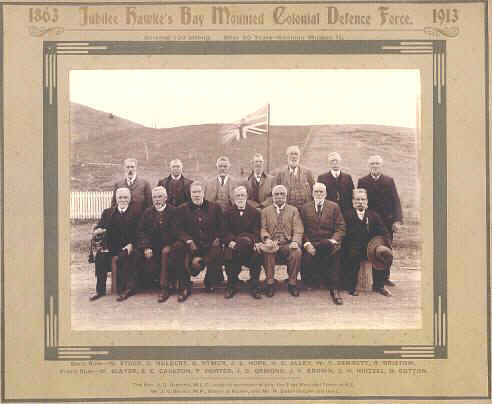|
Thomas
William Potter was born in Streatham, Surrey, England, on 2 August 1843,
the son of John Potter, an agricultural labourer, and his wife, Jane
Phipps. He later changed his name to Porter and claimed to have been
born in India, the son of John William Porter, an officer in the 7th
Bengal Native Infantry, and his wife, Jane Emily Rose. (Thomas sometimes
incorporated 'Rose' into his name.) Details of his early life are
unclear. Porter claimed that he served as a midshipman in the Royal Navy
between 1857 and 1859 and saw active service off the Chinese coast in
1858, and that between 1860 and 1863 he was attached to the 70th
(Surrey) Regiment of Foot in New Zealand.
 |
Porterís
medals in the A G Bairstow Collection |
Between
1863 and 1866 he served in the Colonial Defence Force cavalry in Hawke's
Bay under the name Potter. During this period he began to study the
Maori language. He remained on the east coast after leaving the cavalry,
and, on 9 May 1873 at Gisborne, married Herewaka Porourangi Potai, the
daughter of Ngati Porou leader Tama-i-whakanehua-i-te-rangi; they were
to have at least eight children, among them the tattooer Tame Poata and
the singer Fanny Rose Porter, known as Princess Te Rangi Pai.
In
1868 Porter served with the Ngati Porou contingent fighting Te Kooti. He
performed well enough to be commissioned as an acting sub-inspector in
the Armed Constabulary on 5 January 1869, and given the post of second
in command of its No 8 (Arawa) Division. Porter's division took part in
the final campaign against Titokowaru in Taranaki between January and
April 1869, and in May formed part of the force which invaded the rough
and inaccessible Urewera country. In July 1869 Porter resigned his
commission and returned to the East Coast. There, on 31 August, he
joined the Poverty Bay Mounted Rifle Volunteers, and in October was
commissioned as a Lieutenant in the corps.
 |
Porter
(front row 2nd left) and other veterans of the Hawkes Bay Colonial
Defence Force in 1913.
The
original is held in the A G Bairstow Collection. |
Early
in 1870 Major Ropata Wahawaha named his friend Porter as the European
officer he would like to accompany his force in its expedition into the
Urewera mountains in pursuit of Te Kooti. Porter was commissioned as a
captain in the New Zealand Militia in June 1870 and appointed adjutant
of the East Coast Militia and Volunteer District. Between February 1870
and December 1871 his time was largely spent taking part in a series of
expeditions against Te Kooti. These expeditions traversed extremely
rugged terrain and involved difficult logistic and organisational
problems. Porter acted as Ropata's staff officer, dealing with matters
such as pay and supplies, and as one of his principal subordinates.
During the campaigns Porter "was a marvel
of energy and physical endurance", but his somewhat theatrical and
egotistical personality later led him to consistently overstate his
role.
In
May 1877 Porter was given command of the East Coast Militia and
Volunteer District. Increasingly, however, his time was taken up with
his duties as native officer and land purchase officer. He was
responsible for the implementation of native policy, and had to compile
regular reports and carry out a wide range of administrative tasks. It
is, however, Porter's land purchase work that is of particular
importance. Although not officially appointed land purchase officer
until 1875, from the early 1870s he procured large tracts of Maori land
for the Crown; in the course of his career he purchased nearly one
million acres. Porter's purchasing was facilitated by his command of
Maori, his wife's family connections and his friendship with Ropata.
These relationships, however, also meant that Porter had a personal
interest in some of the land deals he handled for the government, and
led to possibly well-founded charges that he was using his official
position for private gain. |